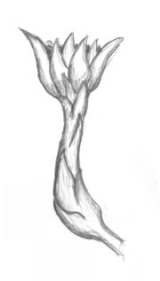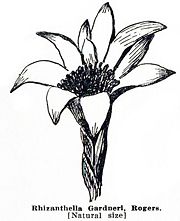
Rhizanthella gardneri
Encyclopedia

Rhizanthella gardneri, also known as Western Underground Orchid, is a plant in the orchid family, discovered in the spring of 1928 in the wheatbelt of Western Australia
Western Australia
Western Australia is a state of Australia, occupying the entire western third of the Australian continent. It is bounded by the Indian Ocean to the north and west, the Great Australian Bight and Indian Ocean to the south, the Northern Territory to the north-east and South Australia to the south-east...
.
Jack Trott had bent to investigate an odd crack that had appeared in his garden's soil, and had noticed a sweet smell that arose from the ground. Scraping away the soil, he soon uncovered a tiny white flower, about half an inch across, growing underground. What he had found was an entirely new type of orchid. The discovery generated such excitement that a wax model was toured around the British Isles.
The white leafless plant is made up of a fleshy underground storage stem (or tuber
Tuber
Tubers are various types of modified plant structures that are enlarged to store nutrients. They are used by plants to survive the winter or dry months and provide energy and nutrients for regrowth during the next growing season and they are a means of asexual reproduction...
), which produces flower head
Flower
A flower, sometimes known as a bloom or blossom, is the reproductive structure found in flowering plants . The biological function of a flower is to effect reproduction, usually by providing a mechanism for the union of sperm with eggs...
consisting of around 150 tightly packed, tiny flowers. Unlike any other orchid in Australia, the Western Australian underground orchid remains completely underground for its whole life. Not being able to obtain the sun's energy, it instead feeds on the broom honeymyrtle
Melaleuca uncinata
Melaleuca uncinata, commonly known as Broombush or Broom Honeymyrtle, is a plant in the Paperbark family native to southern Australia...
, a shrub. It is linked to it by a mycorrhiza
Mycorrhiza
A mycorrhiza is a symbiotic association between a fungus and the roots of a vascular plant....
l fungus
Fungus
A fungus is a member of a large group of eukaryotic organisms that includes microorganisms such as yeasts and molds , as well as the more familiar mushrooms. These organisms are classified as a kingdom, Fungi, which is separate from plants, animals, and bacteria...
named Thanatephorus gardneri.
This particular orchid is a myco-heterotroph as it relies completely on the broom honeymyrtle and fungus for its nutrients and carbon dioxide. Having received this from the fungus the plant is then able to convert the water, nutrients and carbon dioxide into the energy needed for growth and maintenance.
The plant blooms in May and June and measures 2.5–3 cm. The flower head contains 8 to 90 small dark maroon flowers.
Rhizanthella gardneri reproduces vegetatively by which it can produce three daughter plants. They also undergoes sexual reproduction, and underground insects such as termite
Termite
Termites are a group of eusocial insects that, until recently, were classified at the taxonomic rank of order Isoptera , but are now accepted as the epifamily Termitoidae, of the cockroach order Blattodea...
s and gnat
Gnat
A gnat is any of many species of tiny flying insects in the Dipterid suborder Nematocera, especially those in the families Mycetophilidae, Anisopodidae and Sciaridae.In British English the term applies particularly to Nematocerans of the family Culicidae...
s are known to pollinate the flowers, attracted by the fragrance. The pollinated flower will then take six months to mature. In all studied flowers these were not dispersed and eventually decayed, thus releasing their seeds. It may be, however, that native marsupial
Marsupial
Marsupials are an infraclass of mammals, characterized by giving birth to relatively undeveloped young. Close to 70% of the 334 extant species occur in Australia, New Guinea, and nearby islands, with the remaining 100 found in the Americas, primarily in South America, but with thirteen in Central...
s were important dispersal agents, but substantial findings are hard to come by as only 19 mature specimens of the orchid are known to currently exist in the wild and only 300 specimens have been collected to date.
Distribution
The species is endemic to Western AustraliaWestern Australia
Western Australia is a state of Australia, occupying the entire western third of the Australian continent. It is bounded by the Indian Ocean to the north and west, the Great Australian Bight and Indian Ocean to the south, the Northern Territory to the north-east and South Australia to the south-east...
, six populations are currently known; these are found in the central wheatbelt near to the town of Corrigin and from locations close to the south coast.
Conservation
The species is classified as Vulnerable on the 1997 IUCN Red ListIUCN Red List
The IUCN Red List of Threatened Species , founded in 1963, is the world's most comprehensive inventory of the global conservation status of biological species. The International Union for Conservation of Nature is the world's main authority on the conservation status of species...
of Threatened Plants, and listed on Appendix II of the Convention on International Trade in Endangered Species of Wild Fauna and Flora (CITES).
Large areas of bushland
Bushland
Bushland is any area in Australia that is predominantly indigenous flora and fauna.Bushland is the term commonly used by conservation protection groups and other environmental groups as a blanket term for natural vegetation, which may cover any kind of habitat from open shrubby country with few...
have been developed for agriculture in much of southern Western Australia, and it is likely that this loss of habitat
Habitat
* Habitat , a place where a species lives and grows*Human habitat, a place where humans live, work or play** Space habitat, a space station intended as a permanent settlement...
is one of the main causes of the reduced population of Rhizanthella gardneri. Further threats to habitat include drought
Drought
A drought is an extended period of months or years when a region notes a deficiency in its water supply. Generally, this occurs when a region receives consistently below average precipitation. It can have a substantial impact on the ecosystem and agriculture of the affected region...
, the encroachment of salt and a decline in health of the host plant. Remaining populations of the underground orchid are isolated in the fragments of habitat that persist today.
Three of the known populations of Rhizanthella gardneri are protected within nature reserve
Nature reserve
A nature reserve is a protected area of importance for wildlife, flora, fauna or features of geological or other special interest, which is reserved and managed for conservation and to provide special opportunities for study or research...
s, and a concerted initiative has been launched to safeguard this species for future generations. A partnership between the Millennium Seed Bank of the Royal Botanic Gardens, Kew
Royal Botanic Gardens, Kew
The Royal Botanic Gardens, Kew, usually referred to as Kew Gardens, is 121 hectares of gardens and botanical glasshouses between Richmond and Kew in southwest London, England. "The Royal Botanic Gardens, Kew" and the brand name "Kew" are also used as umbrella terms for the institution that runs...
, Australia's Endangered Species Program and Perth's Kings Park and Botanic Gardens
Kings Park, Western Australia
Kings Park is a park located on the western edge of Perth, Western Australia central business district. The park is a mixture of grassed parkland, botanical gardens and natural bushland on Mount Eliza with two thirds of the grounds conserved as native bushland. With panoramic views of the Swan...
are undertaking DNA
DNA
Deoxyribonucleic acid is a nucleic acid that contains the genetic instructions used in the development and functioning of all known living organisms . The DNA segments that carry this genetic information are called genes, but other DNA sequences have structural purposes, or are involved in...
fingerprinting and seed-banking of this rare orchid in an attempt to establish a propagation programme.
Further reading
- Reader's Digest Ltd. (1989). Facts and Fallacies - Stories of the Strange and Unusual. Reader's Digest Ltd. Page 39. ISBN 0864380879.
- Hoffman, N., Brown, A. (1998). Orchids of South-west Australia. University of Western Australia Press, Nedlands.Rev. 2nd ed. with suppl. ISBN 1876268182
- Jones, David L. (2006). A complete guide to native orchids of Australia: including the island territories. Frenchs Forest. ISBN 1-8770-6912-4.

